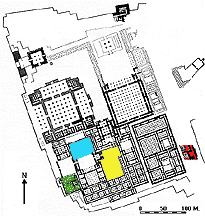Miscellaneous Structures at Persepolis

Near the southeast corner of the Terrace, at the foot of the mountain, were buildings of modest size and insubstantial structure, whose contents indicate that they were quarters for members of the garrison and perhaps for artisans (red). Immediately to the east was a square mudbrick tower, one of a row of towers linked by a 10-meter thick wall that ran along the east edge of the terrace at the foot of the Kuh-i Rahmat and joined the towered defensive wall that ran from the corners of the Terrace up the slope and along the crest of the Kuh-i Rahmat.
The southwestern corner of the Terrace, west of the palace of Xerxes, may once have been the site of a palace of Artaxerxes I, but the standing remains found there belonged a residential structure called Palace H (green), cobbled together by an unknown post-Achaemenid builder from reused pieces of building material and ornament brought from older strutures on the Terrace. The standing remains of Palace G (cyan), north of the Palace of Xerxes, were also from a post-Achaemenid construction on the site of a destroyed older building, perhaps a palace of Artaxerxes III. To the east of the Palace of Xerxes were scraps of Palace D (yellow), probably the substructure of another building that incorporated debris from Achaemenid buildings. Other post-Achaemenid remains included burials in clay coffins were near the spring about 1 km north of the terrace, in a recess at the foot of the mountain.
- Garrison Quarters, Seven Foundation Documents of Xerxes, P 56824
- Garrison Quarters, Findspot of Seven Foundation Slabs in Room 16, P lla
- Fortifications, Excavations in E Complex, Advanced Stage of Work, P 56896
- Fortifications, Excavation of Wall as Seen from the SE Hillock, P 23193
- Fortifications, Passage in N Wall, NE Corner of the Terrace, P 23194
- Palace D, Work on the Site with the Palace of Xerxes in the Background, P 636
- Palace D, Relief Fragment of Small Winged Monster, P 1249
- Palace G, Sculptured Stairway Fragments with Servant Reliefs, Near SW Corner of the Site, PS 27
- Palace G, Sculptured Stairway Fragments with Servant Reliefs, Near SW Corner of the Site, P 1561
- Palace H, Remnants of Facade, P 555
- Palace H, E Stairs, General View, P 28934
- Palace H, Tribute Bearers and Servants on E Stairs, PS 12
- Palace H, Central Panel with an Old Persian Text of Artaxerxes II on the Facade, P 557
- Palace H, Relief Fragment of Cilician(?) Tribute Bearers in the Courtyard to the North, P 28955
- Persepolis Spring Cemetery, the Site near the Shiraz-Isfahan Highway, P 60999
- Persepolis Spring Cemetery, N Group of Burials, P 61042
- Persepolis Spring Cemetery, NE Group of Burials, P 61025
- Persepolis Spring Cemetery, Close-up View of Burial with Lid Removed, P 61007

